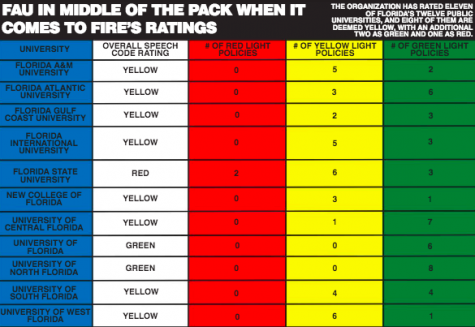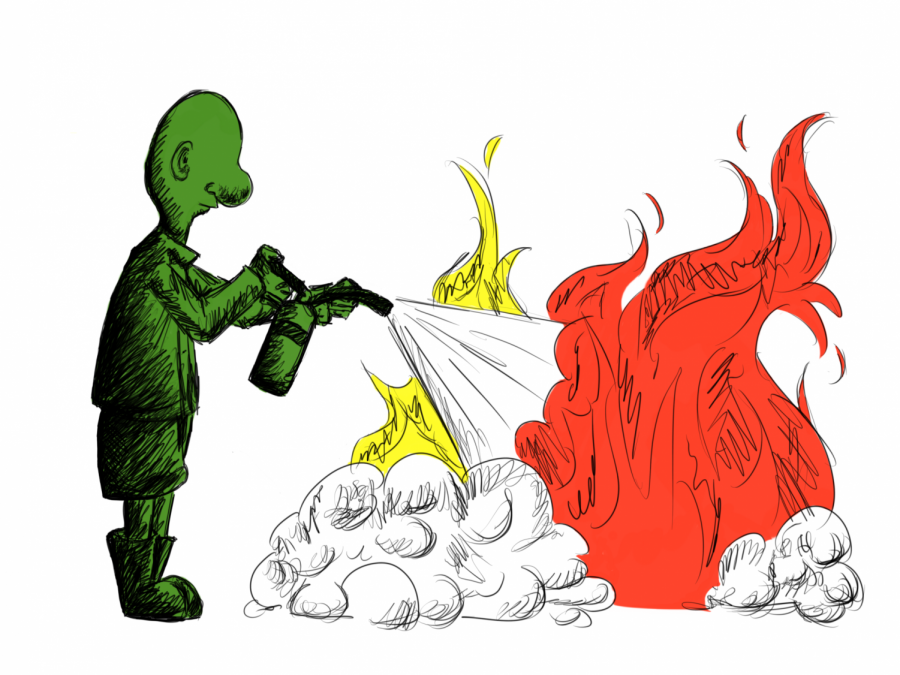FAU’s protection of constitutional rights improves
The Foundation of Individual Rights in Education, or FIRE, has FAU listed as mediocre — but the number of policies that make it so have shrunk.
January 25, 2019
Six years ago, FAU was rated among the worst universities in the country when it came to its’ protection of free speech.
But now it’s in the middle — and improving even further.
The Foundation of Individual Rights in Education (FIRE) is an organization that’s been defending students’ rights since 1999. The non-profit has over 450 universities across the U.S. rated on a scale of harmful to acceptable when it comes to their protection of constitutional rights.
FIRE has been involved in multiple court cases on students’ behalf and uses the media to expose policies that hurt civil liberties, which are guaranteed rights like freedom of speech that the government can’t tread on without a fair trial.
But FAU hasn’t been involved in any of that so far. Instead, its relationship with FIRE has been related to the organization’s Speech Code Ratings, where red is the worst, yellow is mediocre, and green is the best.
In 2013, the university was red. In 2019, it’s yellow — and some of the questionable policies have undergone changes.
The University Press reached out to Dean of Students Larry Faerman and Director of Student Conduct and Conflict Resolution Audrey Pusey for comment, but they did not respond as of publication time.
How does FIRE decide their ratings?
A university’s designated Speech Code Rating is based on the U.S. Constitution, the constitution of the state that the university belongs to, and multiple supreme court cases.
FIRE gives the school an overall color rating before breaking into smaller sections where individual policies are labeled on the same scale.
A green-light rating is one that does “not seriously imperil” free speech or other civil rights, but this does not mean that the university in question “actively supports free expression. It simply means that FIRE is not currently aware of any serious threats to students’ free speech rights in the policies on that campus,” FIRE website specifies.
A yellow-light rating is one that can be “easily be used to restrict protected expression.” These policies are usually too vaguely worded, allowing them to be bent in whatever way the university pleases.
And a red-light rating is one that “unambiguously infringes on what is or should be protected expression.”
Out of all the court cases used to judge policies, one is especially important in FAU’s case — 1999’s Davis v Monroe County Board of Education, which officially outlined what counts as “harassment.” FAU’s yellow-light policies do not adhere to this standard.
According to the outcome, the bothering behavior must be repeated, and the intensity of it has to cross the line of Title IX.
Title IX is a 1972 ruling that bans discrimination under education programs and other activities that receive federal money. The law also states that nobody can be “excluded from participation in [or] denied the benefits of” these programs.
The plaintiff in Davis v Monroe successfully argued that harassment could scare people away from these environments, which would mean the abusers are in violation of Title IX.
But no matter the reason behind FIRE’s rating, it only takes one red-light policy to make an entire school’s Speech Code Rating red.
In fact, this happened to FAU six years ago.
Revised policies: past and future
FAU earned FIRE’s Speech Code of the Month in August 2013, which may sound like a good thing, but wasn’t. Instead, the university’s Speech Code Rating changed to red because of a policy on “Free Speech and Campus Civility” which asked that students “speak to and about one another in ways that are not racist, religiously intolerant or otherwise degrading to others.”
The intent of the policy wasn’t the problem. It was the wording that backfired.
FIRE representative Samantha Harris pointed out in an article that the broad definitions in the policy presented a slippery slope. The ban on “religiously intolerant” speech, for example, could be used to stop discussion against the Israeli/Palestinian conflict, as one side could shut the other down on claims of religious intolerance, she said.
The same could be said for racism, where students discussing immigration and affirmative action could easily be accused of bigotry.
“And the prohibition on ‘otherwise degrading’ speech could apply to speech on virtually any topic that offends another person,” Harris added.
FAU revised the policy in response, changing it to only point out “unlawful” behavior in these types of discussions.
And this is far from the first revised policy in FAU’s history.
According to FAU Media Relations representative Joshua Glanzer, all FAU regulations and policies “are drafted and periodically revised to maintain consistency with the requirements of state and federal law.”
A recent example is FAU’s campus posting policy. It was greenlit just last week on FIRE’s website.
The old version subjected posters and handouts to a university approval process before their distribution, and only departments and student organizations were allowed to distribute. With the new policy, however, regular students can tack up flyers or hand out pamphlets approval as long as the content and place they’re posted is lawful.
The university does not currently have any red-light policies. However, it has plenty of yellow and green ones that affect the student body, so the UP spoke with Beltz to find out what exactly is wrong or right with FAU’s rules.
Current yellow-light policies
University Policy 4.2.4: Distribution of Printed Material
Despite one distribution policy being greenlit, another still needs work.
The new and improved policy claims that it “is applicable to all members of the University community, including all students, faculty, staff and all visitors,” but another policy seems to contradict this.
The outlier is in the most recent version of the Student Organization Manual, and it requires all registered student organizations to have any “flyers, posters, signs and/or notices” stamped and approved by the university before they are sent out.
The UP tried to contact media relations and the Council of Student Organizations on this matter, but they could not be reached before publication time.
University Regulation 4.007: Student Code of Conduct — Violations of the Code of Conduct
This policy outlines sexual harassment as “unwelcome sexual advances, requests for sexual favors, and other verbal, nonverbal, or physical conduct of a sexual nature.”
It also has to “unreasonably” interfere with someone’s work or academic turnout, or create an “offensive” or otherwise negative environment.
However, FIRE believes this definition is far too broad.
“‘Unwelcome conduct of a sexual nature’ could also just be an off-colored joke that someone subjectively didn’t like,” Beltz said. “By leading off with that broad definition, it seems to indicate that anything that is ‘unwelcome conduct of a sexual nature’ is sexual harassment when that’s not the case.”
The definition also doesn’t explain what an “offensive” environment is or mention that the conduct must prevent someone from using institutional resources in order to be punishable, she added.
University Regulation 5.010: Anti-Discrimination and Anti-Harassment Regulation
This policy lays out what the university accepts as general harassment, which includes verbal or physical conduct that:
- Creates an “objectively intimidating, hostile or offensive work or educational environment”
- Interferes with performance or opportunity when it comes to work or academics
But the problem with the policy is its specific examples, such as “jokes based on a protected characteristic,” threats of harm, the use of slurs, and “hostility based on sex or sex-stereotyping.”
These may be able to help students understand what harassment might be, but the policy doesn’t specify that these situations are only harassment if they’re part of a broader pattern of abuse, Beltz said.
Current green-light policies
University Policy 4.2.2: Campus Free Speech
This policy dictates where and when students are allowed to gather to demonstrate. It’s been expanded since last July, when demonstrations were previously restricted to the “free speech lawn” outside the social science building — although Groups can still book the former free speech lawn for their demonstrations if they want to, Glanzer said.
All of campus is a free game now, except for:
- Grounds near residential facilities or the president’s Baldwin House
- Places within 200 feet of the university-operated childcare centers, elementary schools, middle schools, or high schools
- Areas that block entrances or exits to a building or interfere with activities in the building
- Athletic or recreational fields
- Streets and roadways
Demonstrators are also not allowed to use sound amplification devices like megaphones, disrupt or force the cancellation of a speaker, damage property, occupy space overnight, or create permanent or semi-permanent structures.
These restrictions are “reasonable” and make sense, Beltz said: What if student-athletes have to use their fields for practice or a game? Do you really want someone on a microphone five feet away from a classroom when people inside are trying to learn?
University Policy 1.15: Prohibited Sexual Conduct
This policy makes it clear that sex discrimination can be verbal, physical or electronic — and like the others, it must interfere with education or federally-funded activities to be an offense.
Unlike the yellow-light policies, however, this one clearly describes what a “hostile environment” is, and highlights the fact that the repeated conduct must be “severe, persistent or pervasive” enough to create an abusive environment.
This section almost perfectly aligns with the supreme court definition of harassment, which is why it earned the green-light rating, according to Beltz.
University Regulation 4.007: Student Code of Conduct – Violations of the Code of Conduct
This bullying policy is in the same section of the Student Code of Conduct as the yellow-light sexual harassment policy, but unlike the former, it clearly outlines that bullying is “physical hurt or psychological distress” and can include “teasing; social exclusion; threat; intimidation; stalking; physical violence; theft; sexual, religious or racial harassment; public humiliation or destruction of property.”
Another greenlit section of the code goes into general harassment further, explicitly listing coercion and verbal, written and physical abuse as prohibited activities.
These are examples of speech that’s not protected under the First Amendment, Beltz said. The emphasis on repeated behavior is also important here — the policy says it must be “chronic” to be punishable.
Close, but not quite there yet
Beltz encourages revisions and advises for FAU to continually keep a close eye on their laws.
“FIRE always invites school administrations to work with us to revise policies. The ones that … earned that yellow light really aren’t that far from earning a green light rating, so we just encourage the school to work with us to make those changes,” she said.
FAU in middle of the pack when it comes to FIRE’s ratings
The organization has rated eleven of Florida’s twelve public universities, and eight of them are deemed yellow, with an additional two as green and one as red.

Hope Dean is the news editor of the University Press. For information regarding this or other stories, email hdean2015@fau.edu.






